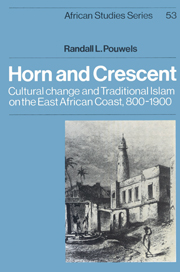Book contents
- Frontmatter
- Contents
- List of illustrations and maps
- Preface
- List of abbreviations
- Introduction
- 1 The roots of a tradition, 800–1500
- 2 The emergence of a tradition, 900–1500
- 3 A northern metamorphosis, 1500–1800
- 4 Town Islam and the umma ideal
- 5 Wealth, piety, justice, and learning
- 6 The Zanzibar Sultanate, 1812–88
- 7 New secularism and bureaucratic centralization
- 8 A new literacy
- 9 The early colonial era, 1885–1914
- 10 Currents of popularism and eddies of reform
- Notes
- Glossary
- Bibliography
- Index
1 - The roots of a tradition, 800–1500
Published online by Cambridge University Press: 23 September 2009
- Frontmatter
- Contents
- List of illustrations and maps
- Preface
- List of abbreviations
- Introduction
- 1 The roots of a tradition, 800–1500
- 2 The emergence of a tradition, 900–1500
- 3 A northern metamorphosis, 1500–1800
- 4 Town Islam and the umma ideal
- 5 Wealth, piety, justice, and learning
- 6 The Zanzibar Sultanate, 1812–88
- 7 New secularism and bureaucratic centralization
- 8 A new literacy
- 9 The early colonial era, 1885–1914
- 10 Currents of popularism and eddies of reform
- Notes
- Glossary
- Bibliography
- Index
Summary
North of Mombasa the coast stands out as a separate ecological zone from the interior. Rendering it especially dramatic definition is the nyika, a parched and jejune wilderness behind the coastal fringe which served throughout history as a natural barrier to all who contemplated travel inland. The nyika usually remains about 15 kilometres from the sea, but as one moves north of the Lamu archipelago it begins approaching the seaside itself. Around the present Kenya–Somalia border, this ‘coastal fringe’ effectively disappears. Thus, the so-called Benadir coast of southern Somalia consists largely of coral outcrops and a sandy shore covered by gigantic dunes of up to 150 metres in height. North of the Jubba River there are few natural harbours and even the best of them, Mogadishu, is of mediocre quality.
As one moves southwards, however, soils and topography improve. The barren dunes gradually yield to a flatter terrain covered with grasses, bush, doum palm, and some savannah vegetation in the region of the Lamu archipelago itself, while the appearance of mangrove swamps grows more and more common. In this region north of the Tana River, soils generally are unsuitable for intensive cultivation and, being essentially sandy, shifting cultivation techniques with long fallow periods of up to fifteen years are required. Such land is suitable for herding activities and for cultivation of dryland cereals (for example, sorghums and millets) and some fruits. Some forests still exist, though it is likely that more extensive forests and, perhaps, somewhat better soils existed before the nineteenth century.
- Type
- Chapter
- Information
- Horn and CrescentCultural Change and Traditional Islam on the East African Coast, 800–1900, pp. 6 - 16Publisher: Cambridge University PressPrint publication year: 1987



